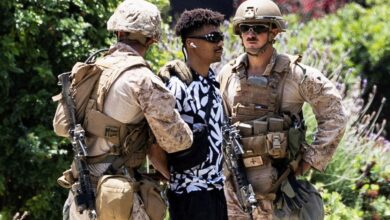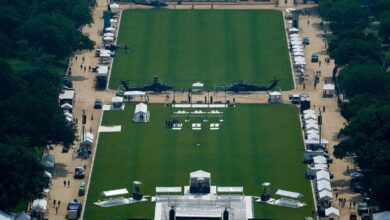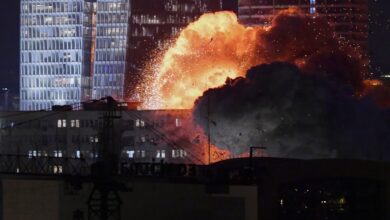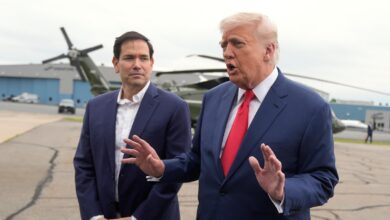LA protests timeline: How ICE raids sparked demonstrations and Trump to send in the military
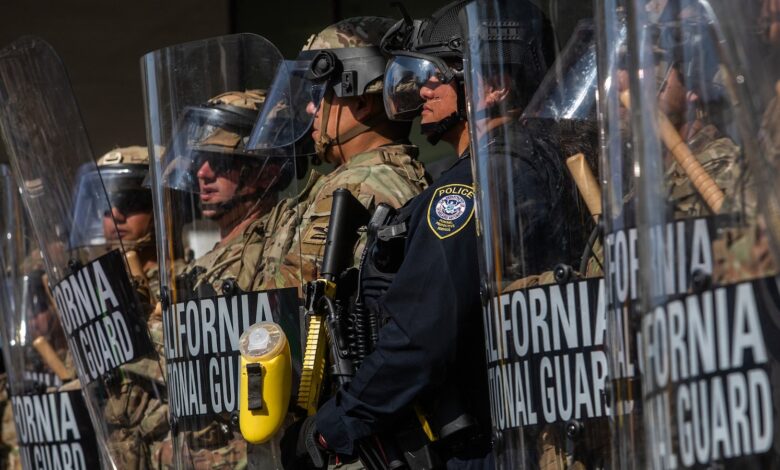
The recent raids in downtown Los Angeles carried out by federal agents have sparked a wave of protests and clashes between law enforcement and demonstrators. Amid the ongoing immigration crackdown by the Trump administration, migrant communities are living in fear, and the recent events in L.A. have escalated tensions even further.
The protests, which have been a mix of peaceful marches and violent confrontations, have led President Trump to deploy the National Guard and Marines in an effort to maintain order. This decision has been met with criticism from local and state leaders, including Los Angeles Mayor Karen Bass and California Governor Gavin Newsom, who have accused Trump of abusing his power and exacerbating an already volatile situation.
The protests in L.A. have centered around the Edward R. Roybal Federal Building and U.S. Courthouse in downtown Los Angeles, where clashes between protesters and law enforcement have turned violent. Demonstrators have engaged in acts of vandalism, set vehicles on fire, and thrown rocks and other projectiles at police officers. In response, law enforcement has used less-lethal projectiles, tear gas, and flash bangs to disperse the crowds.
As the demonstrations continue in Los Angeles and spread to other cities across California and the nation, a timeline of events has emerged:
June 6:
– ICE agents conduct immigration sweeps in Southern California, leading to reports of agents chasing individuals in the Westlake neighborhood near downtown L.A.
– Protesters gather in the downtown Fashion District after ICE agents appear at an apparel manufacturing business, resulting in confrontations between protesters and law enforcement.
– A large group of protesters assembles outside the federal building downtown, calling for an end to immigration raids and engaging in clashes with the police.
June 7:
– Reports surface of a large crowd gathering in Paramount, a suburb of L.A., amid rumors of an impending ICE raid at a Home Depot. The Los Angeles County Sheriff’s Department intervenes, dispersing the crowd with tear gas and flash bangs.
The situation in Los Angeles remains tense as protests continue and the conflict between demonstrators and law enforcement shows no signs of abating. As the nation grapples with the fallout from the immigration crackdown and the use of military force to quell protests, the future remains uncertain for migrant communities and the residents of Los Angeles. As tensions continued to escalate in Los Angeles, a new wave of protests erupted in neighboring Compton, adding to the chaos that had already gripped the city. Reports emerged of vandalism in Compton, with protesters setting a car on fire in the street, further fueling the unrest in the area.
Meanwhile, in Paramount, Mayor Bass clarified that there were no ICE raids taking place in the city or anywhere else in Los Angeles County on Saturday. She explained that the building near which protesters had gathered was being used as a staging area for federal resources, dispelling rumors of immigration enforcement activities in the area.
Later in the evening, around 6 p.m., President Trump signed a presidential memorandum authorizing the deployment of 2,000 National Guard members to Los Angeles. The move was justified as necessary to address the perceived “lawlessness” in the city. However, Mayor Bass and Governor Newsom immediately objected to the president’s decision, citing concerns that the deployment would only exacerbate tensions and further escalate the situation on the ground.
As night fell, protesters at the downtown federal complex continued to clash with law enforcement. Demonstrators were seen throwing fireworks, rocks, glass bottles, and other objects at police, who responded by firing less-lethal projectiles and flash-bangs to disperse the crowd.
The following day, on June 8, National Guard troops began arriving in Los Angeles around 4 a.m., positioning themselves outside the Roybal federal building. This marked the first time a president had mobilized a state’s National Guard without a governor’s consent since President Lyndon B. Johnson did so in 1965 during the civil rights movement in Alabama.
In response to Trump’s deployment of the National Guard, twenty-two Democratic governors released a joint statement condemning the move as an “alarming abuse of power.” They emphasized that governors are the Commanders in Chief of their National Guard units and criticized the federal government for activating troops within state borders without consulting or collaborating with the respective governors.
As the day progressed, a large group of protesters marched through downtown Los Angeles, chanting and holding signs with messages of resistance against the president. The LAPD went on “tactical alert,” preparing for another night of demonstrations. Despite efforts by law enforcement to disperse the crowds, protesters managed to access the 101 Freeway, causing traffic disruptions and further escalating tensions.
During the clashes, two LAPD officers were reportedly injured by motorcyclists attempting to breach police lines. The situation in Los Angeles remained volatile, with both protesters and law enforcement bracing for further confrontations in the days ahead. were seen throwing objects, including a scooter and bicycle, at California Highway Patrol officers and their vehicle as they attempted to remove protesters from the freeway.
Video footage captured the intense confrontation, with demonstrators standing on an overpass hurling objects at the officers below. The chaos escalated as commercial-grade fireworks were also shot at the law enforcement officials, prompting LAPD Chief Jim McDonnell to warn that such actions could be deadly.
The unrest in Los Angeles began on June 9, when the LAPD declared protests in downtown L.A. as acts of “unlawful assembly.” This led to clashes between law enforcement and demonstrators, resulting in arrests and heightened tensions.
In response to the escalating situation, Gov. Newsom formally requested the Trump administration to rescind its “unlawful deployment” of National Guard troops in California. The governor and California Attorney General Rob Bonta also filed a lawsuit against the administration, accusing President Trump and Defense Secretary Pete Hegseth of overstepping their authority.
Meanwhile, U.S. military officials confirmed the deployment of 700 members of the 2nd Battalion, 7th Marines to Los Angeles to assist in maintaining order amid the protests.
As the protests continued into their fourth night, President Trump faced criticism for his handling of the situation. In a social media post, Gov. Newsom condemned the president’s actions, calling them “the acts of a dictator, not a President.”
The images and videos from the scene in Los Angeles painted a stark picture of the unrest and division gripping the city. Despite calls for calm and de-escalation, the clashes between protesters and law enforcement showed no signs of abating, underscoring the deep-rooted tensions and grievances that fueled the demonstrations. On June 10, tensions escalated in Los Angeles as protesters were seen throwing objects at police officers. In response to the growing unrest, an LAPD incident commander authorized the use of “less lethal munitions” to disperse the crowd.
The situation drew international attention, with Mexico’s President Claudia Sheinbaum criticizing the U.S. for “criminalizing migration.” She emphasized the importance of Mexican immigrants in the U.S. economy and condemned the use of force against protesters.
Meanwhile, at the White House, President Trump faced questions about potentially invoking the Insurrection Act in response to the protests. He stated that he would use the act if there was an insurrection, claiming that the protesters were “paid insurrectionists” and “troublemakers.”
In Los Angeles, Mayor Bass declared a local emergency and imposed a curfew in the downtown area from 8 p.m. to 6 a.m. to curb vandalism and looting. The decision came after 23 businesses were looted in one night, and 197 people were arrested for their involvement in the violence.
Governor Newsom condemned President Trump’s deployment of the National Guard and Marines to Los Angeles, accusing him of prioritizing theatrics over public safety. He criticized the administration for conducting ICE raids that targeted immigrant families indiscriminately.
Amidst the escalating tensions, the Department of Defense announced the mobilization of an additional 2,100 California National Guard members to support ICE and federal law enforcement officers in Los Angeles. This move brought the total number of deployed National Guard members to over 4,000.
As the situation continued to unfold, elected leaders, law enforcement officials, and community members planned to meet to discuss the ongoing curfew and strategies to address the protests. The unrest in Los Angeles highlighted the deep-rooted issues of systemic racism and police brutality, sparking a national conversation on the need for meaningful change. the perspective of a researcher studying the effects of climate change on a specific ecosystem.
Title: The Impact of Climate Change on Coral Reefs: A Researcher’s Perspective
Introduction:
As a marine biologist specializing in coral reef ecosystems, I have spent years studying the intricate relationships between coral, algae, fish, and other organisms that make up these vibrant underwater communities. However, in recent years, my research has taken on a new sense of urgency as I witness the devastating effects of climate change on these delicate ecosystems.
Background:
Coral reefs are some of the most diverse and productive ecosystems on the planet, providing habitat for a quarter of all marine species and supporting the livelihoods of millions of people around the world. However, rising global temperatures, ocean acidification, and extreme weather events are threatening the health and resilience of coral reefs.
Research Findings:
Through my research, I have observed firsthand the impact of climate change on coral reefs. Rising sea temperatures have caused coral bleaching events, in which corals expel the algae living in their tissues, leading to the loss of their vibrant colors and eventually their death. Ocean acidification, caused by the absorption of carbon dioxide from the atmosphere, is weakening the skeletons of corals, making them more susceptible to erosion and breakage.
Additionally, extreme weather events such as hurricanes and cyclones are becoming more frequent and intense due to climate change, causing physical damage to coral reefs and disrupting the delicate balance of their ecosystems. As a result, many coral reefs are experiencing a decline in coral cover, biodiversity, and overall health.
Implications:
The consequences of climate change on coral reefs are far-reaching and profound. Not only are these ecosystems vital for biodiversity and ecosystem services, but they also provide food, income, and coastal protection for millions of people worldwide. The loss of coral reefs would have devastating social, economic, and ecological impacts, affecting not only marine life but also human communities that depend on these ecosystems for their survival.
Conclusion:
As a researcher, it is clear to me that urgent action is needed to address the impacts of climate change on coral reefs. By reducing greenhouse gas emissions, protecting marine habitats, and promoting sustainable practices, we can help safeguard these invaluable ecosystems for future generations. It is my hope that through continued research and conservation efforts, we can mitigate the effects of climate change and ensure the long-term health and resilience of coral reefs worldwide.


